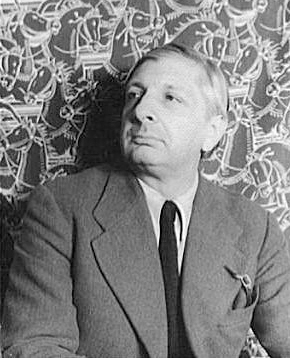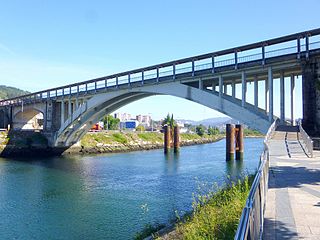Related Research Articles

Paul Jackson Pollock was an American painter. A major figure in the abstract expressionist movement, Pollock was widely noticed for his "drip technique" of pouring or splashing liquid household paint onto a horizontal surface, enabling him to view and paint his canvases from all angles. It was called all-over painting and action painting, since he covered the entire canvas and used the force of his whole body to paint, often in a frenetic dancing style. This extreme form of abstraction divided critics: some praised the immediacy of the creation, while others derided the random effects.

Rialto is a city in San Bernardino County, California, United States, 56 miles east of Los Angeles, near the Cajon Pass, Interstate 15, Interstate 10, State Route 210 and Metrolink routes.

Giuseppe Maria Alberto Giorgio de Chirico was an Italian artist and writer born in Greece. In the years before World War I, he founded the scuola metafisica art movement, which profoundly influenced the surrealists. His best-known works often feature Roman arcades, long shadows, mannequins, trains, and illogical perspective. His imagery reflects his affinity for the philosophy of Arthur Schopenhauer and of Friedrich Nietzsche, and for the mythology of his birthplace.

De Anza College is a public community college in Cupertino, California, United States. It is part of the Foothill-De Anza Community College District, which also administers Foothill College in nearby Los Altos Hills, California. The college is named after the Spanish explorer Juan Bautista de Anza.

Vallecas was a municipality of Spain that disappeared as such in 1950, when its annexation to the municipality of Madrid took place. Nowadays, the territory is roughly occupied by two districts: Puente de Vallecas and Villa de Vallecas.

The Rialto Bridge is the oldest of the four bridges spanning the Grand Canal in Venice, Italy. Connecting the sestieri (districts) of San Marco and San Polo, it has been rebuilt several times since its first construction as a pontoon bridge in 1173, and is now a significant tourist attraction in the city.

The King and the Mockingbird is a 1980 traditionally-animated fantasy film directed by Paul Grimault. Prior to 2013, it was released in English as The King and Mister Bird.
Rialto Film is a German motion-picture production company headquartered in Berlin. It is named after the Rialto in Venice, and used as its production logo an image of a gondola in front of the Rialto Bridge.

Puente Viesgo is a municipality in Cantabria, Spain. Caves have been discovered near Puente Viesgo that contain rock art and artefacts dating back to the Middle and Upper Paleolithic.

The Rialto Center for the Arts is an 833-seat performing-arts venue owned and operated by Georgia State University and located in the heart of the Fairlie-Poplar district in downtown Atlanta, Georgia. The venue is home to the Rialto Series, an annual subscription series featuring national and international jazz, world music, and dance. The Rialto also routinely presents Georgia State University School of Music performances, the annual National Black Arts Festival, and many others.

The Caves of Monte Castillo, located in the Cantabrian town of Puente Viesgo, contain one of the most important Paleolithic sites in the region. The complex of karstic caves is on the slopes of Monte Castillo, a hill south of Puente Viesgo, with an elevation of 354 m. It includes four out of the eighteen caves listed as World Heritage of UNESCO since July 2008 under the title of Cave of Altamira and Paleolithic Cave Art of Northern Spain: El Castillo, Las Chimeneas, and La Pasiega and Las Monedas. In addition, the complex includes a minor fifth cave, La Flecha. The caves are located along the Pas river in the Castillo mountain, squarely at the intersection of three valleys and near the coast.

Emily Mason was an American abstract painter and printmaker. Mason developed her individual approach to the Abstract Expressionist and color field painting traditions with her veils of color and spontaneous gestural mark. Mason was born and raised in New York City, where she lived and worked until her death.

The Miracle of the Cross at the Ponte di Rialto, also known as The Healing of the Madman, is a painting by Italian Renaissance artist Vittore Carpaccio, dating from c. 1496. It is now housed at the Gallerie dell'Accademia in Venice.
Rafael Puente Suárez is a Mexican former professional footballer and manager. He currently works as an analyst for ESPN Deportes and ESPN Mexico.
Enrique Echeverría Vázquez (1923–1972) was a Mexican painter, part of the Generación de la Ruptura and early member of the Salón de la Plástica Mexicana. He was one of a number of painters who broke away from the established painting figurative style in Mexico in the mid 20th century to experiment with abstractionism and other modern movements in painting from Europe. Although his career was followed by other artists and critics, he died in the early 1970s when painters of his generation were only beginning to receive widespread recognition for their work. While meriting two major exhibits at the Palacio de Bellas Artes in Mexico City, one just after his death and a retrospective thirty years later in 2003, he and his work are not well known among younger Mexican painters.
The Spanish artist Salvador Dalí (1904–1989) is known as a surrealist painter: however, he also created or contributed the script, costumes and set designs to a number of ballets, and dance is a motif often found in his painting.

Salerm Cosmetics Puente Genil Fútbol Club, commonly referred to as Puente Genil, is a Spanish football team based in Puente Genil, in the autonomous community of Andalusia. They currently play in the Tercera Federación – Group 10.

The Burgo Bridge(Puente del Burgo) is a medieval bridge, built over an older bridge of Roman origin, which crosses the Lérez River in the city of Pontevedra, Spain. It is on the route of the Portuguese Way to the north of the historic centre of Pontevedra and to the south of the Burgo neighbourhood. Between the arches above the pillars are carved the famous stone pilgrim's shells.

The Barca Bridge is a bridge over the Lérez River, at its mouth in the Pontevedra Ria, which connects the city of Pontevedra with the municipality of Poio in Spain.

The Plaza de España is a 19th century pedestrian square located in the city centre of Pontevedra (Spain), on the edge of the old town and the Alameda de Pontevedra.
References
- ↑ Varios, Museo Soumaya, Ed. Fundación Carlos Slim, México 2015, p. 119.